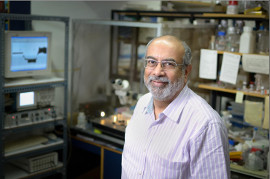Prof. M. K. Mathew
The MKM laboratory has studied transmembrane proteins for over 25 years. We have chosen systems that were both challenging in themselves and parts of larger pictures that were exciting. We have worked on the voltage-gated K+ channel, which soon became the best-studied membrane protein of its time. Our model of the mechanism coupling changes in transmembrane potential to the opening or closing of the channel is, arguably, the one that best explains the available data. We have spent some time understanding transporters involved in cell death and shown Voltage Dependent Anion Channel (VDAC) to be a key player in mitochondrial pathways leading to cell death and that trafficking and localisation of VDAC modulates cell death. On a completely different front we have demonstrated mechanisms involved in conferring salt tolerance to crop plants where, we have discovered at least three previously unreported mechanisms that contribute to salt tolerance in crop plants. More recently, we have studied K+ channels of the heart and found that the electrical systems in the heart are sensitive to mechanical forces.
Highlighted publications (in reverse chronological order)
- Roy S & Mathew MK. Fluid flow modulates electrical activity in cardiac hERG potassium channels. J Biol. Chem. 2018;293:4289-4303.
- Dubey AK, Godbole A, Mathew MK. Regulation of VDAC trafficking modulates cell death. Cell Death Discov. 2016;2:16085.
- Baral A, Irani NG, Fujimoto M, Nakano A, Mayor S, Mathew MK. Salt-induced remodeling of spatially restricted clathrin-independent endocytic pathways in Arabidopsis root. The Plant Cell. 2015;27(4):1297-315.
- Upadhyay SK, Nagarajan P, Mathew MK. Potassium channel opening: a subtle two-step. J Physiol. 2009;587(15):3851-68.
- Krishnamurthy P, Ranathunge K, Franke R, Prakash HS, Schreiber L, Mathew MK. The role of root apoplastic transport barriers in salt tolerance of rice (Oryza sativa L.). Planta. 2009;230(1):119-34.
- Godbole A, Varghese J, Sarin A, Mathew MK. VDAC is a conserved element of death pathways in plant and animal systems. BBA-Mol Cell Res. 2003;1642(1-2):87-96.



